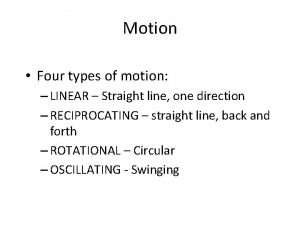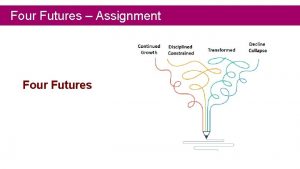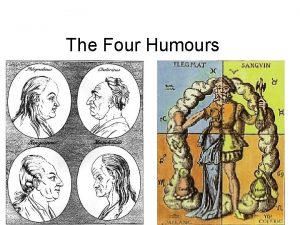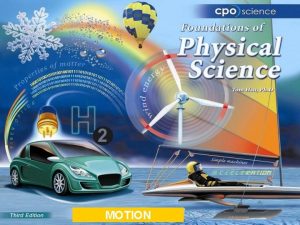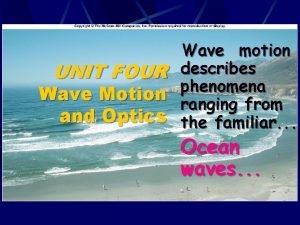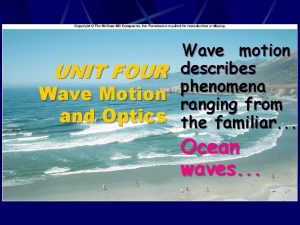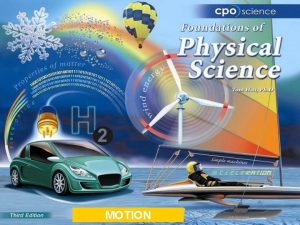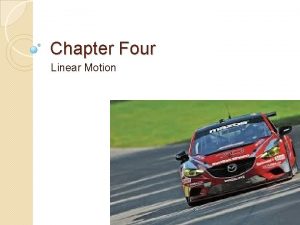Types of Motion What are the four types










![11 Your Turn! 1. A car is driven at 100. 0 km/h [W] for 11 Your Turn! 1. A car is driven at 100. 0 km/h [W] for](https://slidetodoc.com/presentation_image_h/1f7a18c8e6b79bc3194b43dde8312960/image-11.jpg)


- Slides: 13

Types of Motion

What are the four types of motion?

Types of Motion • Stationary ▫ no motion • Constant Velocity ▫ moving at a constant distance per second • Constantly changing velocity ▫ moving with a constant acceleration • Changing acceleration ▫ Constant jerk ▫ We don’t analyze this type of motion

Terminology we need: • Position – your location with respect to a reference point • Displacement – a change in position

Stationary Motion • What does stationary motion involve? ▫ Constant position ▫ Zero displacement

Constant Velocity • What does this mean? Ideas?

Average Speed • The rate at which an object covers distance • SCALAR quantity

Average Velocity • The rate at which an object changes position • VECTOR quantity (magnitude & direction)

9 (m) Total distance = d. T = 95 m Displacement = Δd = 55 m [L] 1. Find the person’s average speed. 2. Find the person’s average velocity.

10 Total distance = d. T = 420 m Displacement = Δd = 140 m [R] • • Determine the skier’s average speed. Determine the skier’s average velocity.
![11 Your Turn 1 A car is driven at 100 0 kmh W for 11 Your Turn! 1. A car is driven at 100. 0 km/h [W] for](https://slidetodoc.com/presentation_image_h/1f7a18c8e6b79bc3194b43dde8312960/image-11.jpg)
11 Your Turn! 1. A car is driven at 100. 0 km/h [W] for 45 minutes, then 90. 0 km/h [E] for 75 minutes, and then at 80. 0 km/h [W] for 65 minutes. a. Draw (up to scale) vectors to represent the velocity for each interval b. Determine the displacement at each interval and total displacement; c. compare displacement to the total distance travelled d. what’s the average speed for the trip and the average velocity for the trip [displtot=48. 9 km[W]] [disttot=274 km] [89. 0 km/h, 15. 9 km/h[W]]

12 And Again… 2. An animal runs for a total time of one minute and 10 seconds. It runs at 8. 0 m/s [R] for 15 s, and then 4. 5 m/s [L] for 40 s. It then runs to the Right for the rest of the trip. a. Draw a vector diagram to represent the animal’s position during each interval. b. If its average velocity for the entire trip was 0. 43 m/s [R], find its displacement during the final leg of the trip. (d 1= 120 m[R], d 2=180 m[L], dtot=30 m[R], d 3=90 m[R])

13 And Finally… 3. A person runs at a constant speed once around a circular track as shown to the right. The total time taken for one revolution is 105 seconds. FIND a. The average speed for the trip [5. 9 m/s] b. The average velocity for the trip [0 m/s] c. The average velocity from B to D[3. 8 m/s[L]]
 Antigentest åre
Antigentest åre Types of motion
Types of motion Equation of shm
Equation of shm An object in motion stays in motion
An object in motion stays in motion Chapter 2 motion section 1 describing motion answer key
Chapter 2 motion section 1 describing motion answer key Chapter 2 motion section 1 describing motion answer key
Chapter 2 motion section 1 describing motion answer key Chapter 2 section 1 describing motion answer key
Chapter 2 section 1 describing motion answer key Section 1 describing motion worksheet answer key
Section 1 describing motion worksheet answer key Motion section 1 describing motion
Motion section 1 describing motion Hát kết hợp bộ gõ cơ thể
Hát kết hợp bộ gõ cơ thể Frameset trong html5
Frameset trong html5 Bổ thể
Bổ thể Tỉ lệ cơ thể trẻ em
Tỉ lệ cơ thể trẻ em Chó sói
Chó sói
















